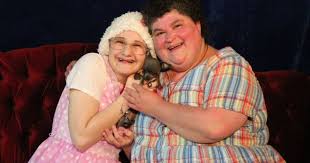Mommy Dearest: Most Toxic Mother-Daughter Relationship to Ever Exist
July 24, 2017

The bond between a mother and her daughter can be incredibly strong, and form the basis for one of the most important relationships in either woman’s life.
It can also be unbelievably damaging, as both women often see and embody behavior mirrored in each other.
History is rife with bad mothers, and not just those who were simply unsure of their commitment to motherhood.
Some suffer horrible mental deficiencies that render them ill-suited to the travails of childcare.
Others still are just selfish, egomaniacal, or desperately insecure women who take out their frustrations on their daughters. Stage mothers, broken divas, codependent psychotic women – the list goes on and on.
Here are a few of the most infamously atrocious mother-daughter relationships, and the havoc they wreaked.

1. Dee Dee and Gypsy Rose Blancharde
Perhaps the most heartbreaking and bizarre story to appear in the news recently, Dee Dee and Gypsy’s story is a haunting mix of child abuse and mental illness that ended horrifically.
Dee Dee, a single mother who lived a somewhat nomadic life mostly in the South, was obsessively protective of her daughter, Gypsy.
Claiming that she suffered from cancer and a multitude of diseases that rendered Gypsy invalid, Dee Dee took her daughter from doctor to doctor, subjecting her to one invasive procedure after the next, kept her on a mostly liquid diet of nutritional supplements, and ensured Gypsy remained wheelchair bound.
The mother-daughter duo were considered the sweetest and most loving pair, and they went on numerous Make-a-Wish Foundation retreats, received gifts, plenty of positive media attention, etc.
The thing is Gypsy was not sick. But Dee Dee, who most likely had Munchausen Syndrome by proxy, convinced her daughter, their community, and anyone who would listen, that Gypsy was cognitively disabled and unable to walk.
To keep up the charade, Dee Dee had Gypsy subjected to unnecessary and increasingly cruel surgeries, such as removing her salivary gland, forced-feeding tube insertion, and shaving her head regularly to appear sick and much younger than her 18 years.
The physical toll on Gypsy was immense; her teeth rotted and fell out, and her mother kept her away from the outside world, monitoring the girl’s use of the internet, ability to talk to her dad in private, have friends, or any sense of normalcy.
Things came to a head when Gypsy somehow managed – despite her mother’s constant surveillance – to meet her first boyfriend online. Together, they plotted an attempt to escape her mother’s clutches.
One night, her boyfriend, Nicholas, broke into the home and stabbed Dee Dee to death in her bed. Gypsy, who was initially thought to be missing, posted on her Facebook account a few hours later, “The bitch is dead!”
Both she and Nicholas were on the run till their arraignment a few days later.
It took family, friends, and the media a few days to realize the truth; Gypsy was not cognitively disabled, she could walk, she had never been sick, and she was not kidnapped.
She lived with a psychotically abusive mother whose mental illness went undiagnosed for many years.
The macabre web of lies Dee Dee strung together since Gypsy’s birth unfolded quickly in the public eye, and the surreal events have since captured the imagination of many.
A recent documentary, Mommie Dead and Dearest explores in detail their grotesque and tragic relationship.

2. Joan Crawford and Christina Crawford
The screech “No more wire hangers!” can still be heard echoing across many film screenings of the cult classic, Mommie Dearest.
The ultimate dreadful mother-daughter relationship film has proven to be enormously influential, and is even referenced by the filmmakers who made the documentary on Dee Dee and Gypsy Rose mentioned above.
The legendary film actress, Joan Crawford, remains one of the most idolized and important stars of the 20th Century.
However, you would be hard-pressed to bring up her name without mentioning the book, Mommie Dearest, which her adopted daughter, Christina, wrote about their tormented relationship.
Christina alleged that her mother – in response to being labeled “box office poison” by studio heads – adopted a coterie of children to help soften her image.
The book detailed Crawford’s alcohol induced fits of rage, violently beating her daughter with random objects, and even strapping Christina’s younger brother to his bed every night, preventing him from sleepwalking.
Staged photo ops in which Christina was forced to kiss and hug her mother on camera ran parallel to days-long induced starvation, during which Crawford would punish her daughter for being a picky eater by hiding food.
Or, in another attempt at discipline, Crawford would recklessly throw away all of the child’s possessions.
Perhaps the most toxic era of their relationship occurred when Christina was older.
At 28, the young woman had made a successful debut on a television soap opera and secured a recurring role for a season.
However, while Christina lay bedridden in a hospital recovering from an ovarian cyst, Joan made a point of taking over her daughter’s role.
It should be noted that the network, for some strange reason, agreed, despite the fact that the actress was well into her 60s at this point.
Towards the end of her life, Christina and Joan Crawford were on their way to making amends, when, after the actress passed away, her children found out that they were written out of the will.
While Christina might have been able to tarnish her mother’s gilded legacy in pop culture, Joan arguably had the last cruel laugh.

3. Little Edie and Big Edie
Little Edie and Big Edie, the stars of the groundbreaking, and undeniably creepy, documentary Grey Gardens, are one of the most notorious mother-daughter teams ever.
With roots in old money and East Coast aristocracy, both women lived out their older years in unimaginable squalor.
While they undoubtedly loved each other, their relationship was definitely odd and damaging, perhaps especially so for the vulnerable Little Edie.
Born Edith Bouvier Beale, and Edith Ewing Bouvier Beale senior, respectively, the women were cousins of Jacqueline Kennedy Onassis and came from a moneyed life.
Big Edie nurtured dreams of becoming a singer, which she abandoned when her husband – and Little Edie’s father – left her in 1931 to care for the burgeoning family.
In some ways, inheriting her mother’s creative spark, Little Edie left home as she embarked on her 20s, looking for fame and fortune as a fashion model and dancer in New York City.
Sadly, her luck ran out as she developed alopecia totalis, causing her to lose all her hair, which led to the infamous headscarves and sometimes skirts she wore on her head.
She was also not so lucky in love, as her mother – in the first sign of future codependency and jealousy – would scare away Little Edie’s suitors.
As Big Edie advanced in age, her health deteriorated, and she begged Little Edie to return home and take care of her and their estate, Grey Gardens.
This is when their relationship truly became the stuff of textbook codependency 101. The women became more and more isolated over time.
Destitute, they sold pieces of their Tiffany’s silverware one by one to help make ends meet.
In what some considered a rather bold move, the two women slowly withdrew from the high society of which they were once a part, shunning the pomp and circumstance of their blue-blooded heritage and escaping into an increasingly erratic household.
Mired in daily rituals of bickering, breaking suddenly into eerie song and dance routines, and eating semi-rotten food – as documented in the Maysles brothers’ film.
The women inadvertently made headlines in 1971 when local health sanitation officials ordered them to clean the house or risk eviction.
The media frenzy reached a fever pitch when their famous cousin, Jacqueline Kennedy Onassis, gave them money to help restore the home.
The fascination with Little and Big Edie culminated in the landmark documentary by the Maysles brothers, as people openly wondered how and why the women shunned their patrician heritage and descended into madness.
The question remained if the staunch outsiders were bravely rebelling against societal expectations of them, or if their relationship was simply too close for comfort.
Mostly though, no one could believe that they lived in these conditions: the house was overrun by feces, wild animals, with the ceiling practically caving in, and more, all to its seemingly oblivious inhabitants.
Little Edie’s loneliness became more difficult to bear, as she recounted a number of suitors who had asked for her hand in marriage, but her mother, Big Edie, toxically cut them out of the picture.
Made self-conscious by her alopecia, and losing touch with nearly all her friends, Little Edie desperately fumbled for attention of any kind, from hilariously flirting with the young man tasked with helping to run their errands, or random sanitation workers attempting to work on the creepily dilapidated estate.
By all accounts, Big Edie seemed terrified of losing both her daughter and the claim on her estate, Grey Gardens, so she clawed deep into them, no matter the cost.
Even if it came at the expense of her increasingly susceptible and grief-stricken daughter.
Big Edie passed away in the late 1970s, and Little Edie found a way to sell the house, despite her mother’s refusal to do so.
In a final and surprising moment of total rebellion against her mother, Little Edie declined to be buried next to her, instead choosing a different resting place once the time came in 2002.
Like Mother, Like Daughter?
While there are some instances in which mothers can be entirely unhinged, given the burden of an undiagnosed mental illness, or alcohol abuse, most usually have a hard time coping in the real world without becoming overly reliant on their daughters.
A poisonous jealousy of their youth and a creepy sense of codependency can lead to outright rebellion from their offspring, resulting in tragic consequences.
In other relationships, the daughter ends up mimicking her mother’s worse tendencies, passing on the elders’ sins from one generation to the next, till somehow the cycle breaks: oftentimes, violently.
